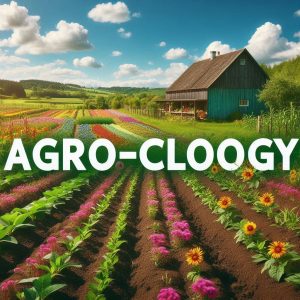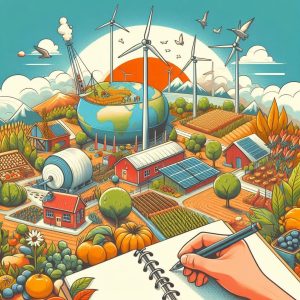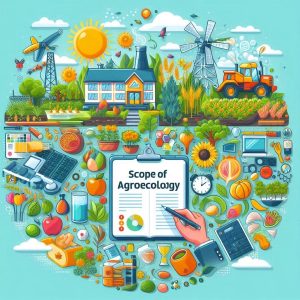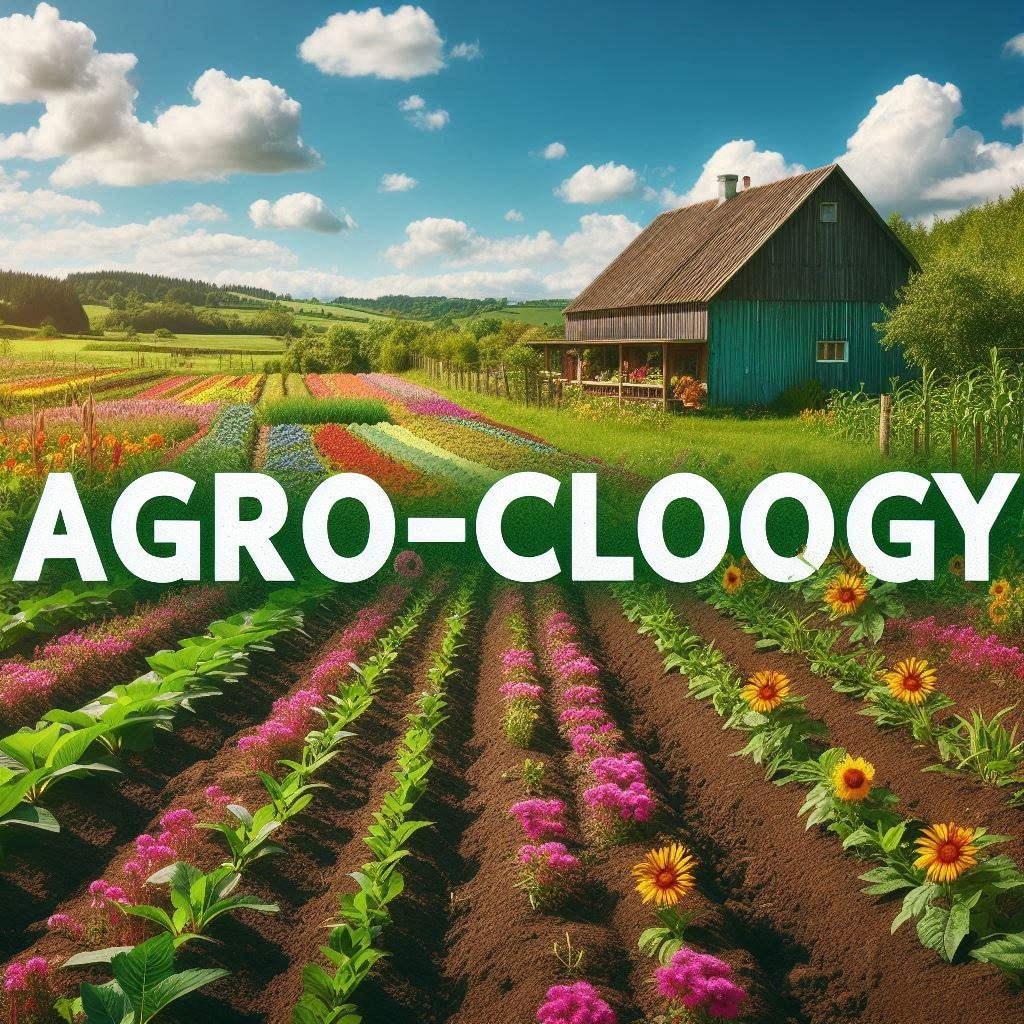Introduction to Agroecology
Agroecology is an integrated approach that applies ecological concepts and principles to the design and management of sustainable agricultural systems. It is both a science and a set of practices aimed at enhancing the productivity, sustainability, and resilience of agricultural landscapes. For a detailed overview, visit FAO Agroecology Overview.
At its core, agroecology seeks to harmonize agriculture with the natural environment by mimicking the processes and interactions found in natural ecosystems. This includes fostering biodiversity, improving soil health, and utilizing natural resources efficiently. By focusing on ecological relationships, agroecology aims to create farming systems that are environmentally sound and socially just. Learn more at CBD Agroecology.
Agroecology goes beyond traditional agricultural practices by integrating local knowledge and cultural practices with scientific research. It promotes a holistic view of farming that considers the interconnections between plants, animals, humans, and the environment. This approach not only enhances the resilience of farming systems but also supports rural communities and their livelihoods. For more information, visit IIED Agroecology.
One of the key aspects of agroecology is its focus on diversification. Diverse cropping systems and integrated livestock management are fundamental to agroecological practices. This diversity helps to stabilize yields, improve resilience to climate change, and reduce the risk of pests and diseases. For further reading, check out CGIAR Agroecology.
| Aspect | Description |
|---|---|
| Ecological Principles | Applying ecological concepts to enhance agricultural sustainability. |
| Biodiversity | Promoting diverse species and genetic resources in farming systems. |
| Local Knowledge | Integrating traditional practices and cultural knowledge with scientific research. |

History of Agroecology
Agroecology, as a concept and practice, has evolved significantly over time. Its roots can be traced back to traditional agricultural practices that have been used by indigenous and local communities for centuries. These early practices were inherently ecological, focusing on biodiversity, crop rotation, and sustainable land management. To learn more, visit FAO Agroecology History.
The formal study of agroecology began in the early 20th century, with scientists and researchers exploring the ecological relationships within agricultural systems. The term “agroecology” was first coined in the 1930s by agronomist Basil Bensin. Bensin’s work emphasized the importance of studying agricultural systems as ecosystems, considering the interactions between plants, animals, and their environment. For more on Basil Bensin’s contributions, visit Cambridge University Press.
In the 1960s and 1970s, the Green Revolution introduced high-yielding crop varieties and chemical inputs to agriculture. While this led to increased food production, it also caused significant environmental degradation and social inequalities. In response, the agroecology movement gained momentum as a sustainable alternative to conventional agriculture. For a deeper understanding of the Green Revolution’s impact, visit National Geographic.
During the 1980s and 1990s, agroecology expanded as a scientific discipline, incorporating insights from ecology, agronomy, and social sciences. Researchers like Miguel Altieri and Stephen Gliessman played pivotal roles in defining and promoting agroecological principles and practices. Their work highlighted the benefits of biodiversity, polycultures, and organic farming methods. Learn more about their contributions at ResearchGate.
In recent decades, agroecology has gained recognition as a vital approach to addressing global challenges such as climate change, food security, and biodiversity loss. International organizations, including the Food and Agriculture Organization (FAO) and the United Nations, have endorsed agroecology as a pathway to sustainable food systems. For more on this global endorsement, visit FAO Agroecology.
| Period | Milestone | Key Figures |
|---|---|---|
| Early 20th Century | Formal study of ecological relationships in agriculture | Basil Bensin |
| 1960s-1970s | Response to Green Revolution’s environmental and social impacts | – |
| 1980s-1990s | Expansion of agroecology as a scientific discipline | Miguel Altieri, Stephen Gliessman |
| 2000s-Present | Global recognition and endorsement by international organizations | – |
Principles and Practices
The core principles of agroecology include promoting biodiversity, maintaining healthy soil, and reducing dependency on synthetic inputs. Practices such as crop diversification, agroforestry, and integrated pest management are central to agroecology. These methods not only enhance productivity but also contribute to environmental sustainability. For more detailed information, visit IFOAM.
Promoting Biodiversity: Biodiversity is a cornerstone of agroecology. Diverse cropping systems enhance ecosystem services, such as pollination, pest control, and soil health. By incorporating a variety of plant species, farmers can create more resilient and productive agricultural landscapes. For further reading, check out CBD Agroecology.
Maintaining Healthy Soil: Soil health is fundamental to agroecological practices. Techniques like cover cropping, composting, and reduced tillage help maintain soil structure, enhance organic matter, and improve water retention. Healthy soils lead to healthier crops and ecosystems. More information can be found on the FAO Soils Portal.
Reducing Dependency on Synthetic Inputs: Agroecology emphasizes the use of natural inputs over synthetic chemicals. This includes the use of organic fertilizers, biopesticides, and natural pest control methods. Reducing synthetic input dependency decreases environmental pollution and improves the sustainability of farming systems. Visit Organic Consumers Association for more insights.
Benefits of Agroecology
Agroecology offers numerous benefits including improved food security, increased biodiversity, and enhanced resilience to climate change. By focusing on sustainable practices, agroecology supports the creation of food systems that are both environmentally friendly and socially equitable. Learn more about these benefits on CGIAR.
| Practice | Benefits |
|---|---|
| Agroforestry | Enhances biodiversity, improves soil structure, and increases carbon sequestration. |
| Integrated Pest Management | Reduces the need for chemical pesticides and promotes natural pest control. |
| Crop Diversification | Improves soil health and reduces risk of crop failure. |
Principles and Practices
The core principles of agroecology include promoting biodiversity, maintaining healthy soil, and reducing dependency on synthetic inputs. Practices such as crop diversification, agroforestry, and integrated pest management are central to agroecology. These methods not only enhance productivity but also contribute to environmental sustainability. For more detailed information, visit IFOAM.
Promoting Biodiversity: Biodiversity is a cornerstone of agroecology. Diverse cropping systems enhance ecosystem services, such as pollination, pest control, and soil health. By incorporating a variety of plant species, farmers can create more resilient and productive agricultural landscapes. For further reading, check out CBD Agroecology.
Maintaining Healthy Soil: Soil health is fundamental to agroecological practices. Techniques like cover cropping, composting, and reduced tillage help maintain soil structure, enhance organic matter, and improve water retention. Healthy soils lead to healthier crops and ecosystems. More information can be found on the FAO Soils Portal.
Reducing Dependency on Synthetic Inputs: Agroecology emphasizes the use of natural inputs over synthetic chemicals. This includes the use of organic fertilizers, biopesticides, and natural pest control methods. Reducing synthetic input dependency decreases environmental pollution and improves the sustainability of farming systems. Visit Organic Consumers Association for more insights.
Agroforestry
Agroforestry involves integrating trees and shrubs into agricultural landscapes. This practice provides multiple benefits, including improved soil fertility, reduced erosion, enhanced biodiversity, and increased carbon sequestration. Agroforestry systems can include alley cropping, silvopasture, and forest farming. Learn more about agroforestry practices at Agroforestry.org.
Benefits of Agroecology
Agroecology offers numerous benefits that span environmental, economic, and social dimensions. By applying ecological principles to agriculture, agroecology promotes sustainable farming practices that enhance productivity and resilience. For more on the benefits of agroecology, visit CGIAR Agroecology.
Environmental Benefits: One of the primary benefits of agroecology is its positive impact on the environment. Agroecological practices enhance biodiversity, improve soil health, and reduce dependency on chemical inputs. By promoting a diverse ecosystem, agroecology supports natural pest control, pollination, and nutrient cycling. These practices lead to more resilient farming systems that are better equipped to withstand environmental stresses. Learn more at IUCN.
Economic Benefits: Agroecology can also enhance economic sustainability for farmers. By reducing the need for expensive synthetic inputs and promoting efficient use of resources, agroecology helps lower production costs. Additionally, diversified farming systems can provide multiple sources of income and reduce financial risk. For more insights, visit World Bank Agroecology.
Social Benefits: Agroecology supports social sustainability by promoting equitable food systems and empowering local communities. It encourages the use of local knowledge and resources, fostering community resilience and food sovereignty. Agroecological practices can improve access to nutritious food and create job opportunities in rural areas. For further reading, check out FAO Agroecology.
| Benefit | Description |
|---|---|
| Improved Soil Health | Enhanced soil structure, increased organic matter, and better water retention. |
| Increased Biodiversity | Diverse cropping systems support ecosystem services and resilience. |
| Economic Viability | Lower production costs and diversified income sources reduce financial risk. |
Global Impact and Case Studies
Around the world, agroecology is transforming agricultural landscapes. In Brazil, the Zero Hunger Program incorporates agroecological principles to combat poverty and food insecurity. This program has helped millions of people by promoting sustainable farming practices and improving local food systems. More details can be found on the FAO Zero Hunger Initiative.
In Africa, initiatives like World Agroforestry are making significant strides. These projects focus on integrating trees into agricultural landscapes, which enhances soil fertility, provides shade, and helps mitigate climate change. The success of these projects demonstrates the potential for agroecology to improve livelihoods and environmental health.
In Asia, countries like India are adopting agroecological practices to tackle issues of land degradation and water scarcity. The DHAN Foundation works with local communities to implement sustainable farming techniques, which has led to increased crop yields and improved water management.
Europe is also witnessing a rise in agroecological farming, with the European Union promoting policies that support sustainable agriculture. The Agroecology Europe Association is a key player in advocating for agroecological practices across the continent, aiming to create a more sustainable and resilient food system.

Challenges and Future Directions
Despite its benefits, agroecology faces significant challenges. Policy barriers, such as subsidies favoring conventional farming, hinder the widespread adoption of agroecological practices. Additionally, there is a lack of awareness and education among farmers about the benefits and techniques of agroecology. Access to resources such as organic fertilizers and biopesticides is also limited in many regions. More on these challenges can be found on the IIED website.
To overcome these challenges, future directions for agroecology include integrating modern technology, enhancing farmer education, and fostering supportive policies. For instance, digital tools and platforms can provide farmers with real-time data and analytics to optimize their farming practices. Educational initiatives aimed at both farmers and consumers can raise awareness about the benefits of agroecology and drive demand for sustainably produced food. Policies that support organic farming and sustainable practices are crucial for the future of agroecology. More information on these initiatives can be found at FAO.
Organizations like FAO and IFOAM are working towards overcoming these challenges by promoting global collaborations and sharing best practices. They are also advocating for policies that support agroecological practices and investing in research and development to innovate new solutions. The future of agroecology looks promising, with a growing movement of farmers, researchers, and policymakers dedicated to creating sustainable and resilient food systems.
FAQs
Q1: What is agroecology?
A: Agroecology is an approach to farming that focuses on the ecological relationships within agricultural systems. It integrates principles of ecology, agronomy, and social sciences to create sustainable and resilient food systems. Learn more at FAO Agroecology.
Q2: How does agroecology differ from conventional farming?
A: Unlike conventional farming, which often relies on chemical inputs and monocultures, agroecology emphasizes biodiversity, soil health, and sustainable practices. It seeks to balance productivity with environmental and social well-being. For more details, visit Soil Association.
Q3: What are the benefits of agroecology?
A: Agroecology offers numerous benefits, including improved soil health, enhanced biodiversity, reduced dependency on chemical inputs, and increased resilience to climate change. Additionally, it promotes social equity and local food systems. Discover more benefits at Agroecology Pool.
Q4: Can agroecology feed the world?
A: Yes, agroecology has the potential to contribute significantly to global food security. By enhancing the sustainability and resilience of agricultural systems, it can help meet the growing demand for food in a sustainable manner. For more insights, visit FAO Agroecology.
Q5What Do You Mean by Agroecology?
Agroecology is an interdisciplinary approach that applies ecological principles to agricultural systems. It focuses on creating sustainable and resilient farming practices that work in harmony with natural ecosystems. By integrating knowledge from ecology, agronomy, and social sciences, agroecology seeks to enhance biodiversity, improve soil health, and promote sustainable food production. This approach is gaining traction as a viable alternative to conventional farming methods, which often rely on chemical inputs and monocultures. For a comprehensive overview, visit FAO Agroecology Overview.
Q6 What is the Role of Agroecology
Agroecology plays a critical role in transforming our food systems to be more sustainable and resilient. It focuses on enhancing the health of ecosystems and communities by integrating ecological principles into agricultural practices. Key roles of agroecology include:
- Promoting biodiversity in farming systems, which helps to increase resilience against pests and diseases. Learn more from Greenpeace.
- Improving soil health and fertility through practices such as crop rotation, cover cropping, and organic amendments. For detailed insights, visit Soil Association.
- Reducing dependency on synthetic inputs like pesticides and fertilizers, thereby minimizing environmental pollution. Check out Pesticide Action Network UK for more information.
- Supporting local food systems and economies by encouraging the use of locally adapted crops and traditional knowledge. Discover more at Agroecology Now!.
Overall, agroecology aims to create a more equitable and sustainable agricultural system that benefits both people and the planet.
Q7: Difference Between Organic Farming and Agroecology?
Difference Between Organic Farming and Agroecology:
While both organic farming and agroecology aim to create sustainable agricultural systems, they differ in scope and principles. Here’s a detailed comparison:

Scope and Principles
Organic farming primarily focuses on avoiding synthetic chemicals and genetically modified organisms (GMOs). It emphasizes the use of natural inputs, crop rotations, and organic fertilizers. The principles of organic farming include:
- Restriction of synthetic inputs: Organic farming prohibits the use of synthetic pesticides, herbicides, and fertilizers. For more on this, visit IFOAM – Organics International.
- Soil health: Organic practices enhance soil fertility through composting and green manures. Check out Organic.org for more information.
- Biodiversity: Organic farms typically promote biodiversity through diverse cropping systems and integrated pest management.
Agroecology: A Broader Perspective
Agroecology encompasses a broader range of principles and practices beyond those of organic farming. It integrates ecological, social, and economic aspects of agriculture. Key elements include:
- Ecological principles: Agroecology applies ecological concepts such as energy flow, nutrient cycling, and biodiversity to agricultural systems. For a deeper dive, visit FAO Agroecology.
- Social and economic dimensions: It considers social equity and economic viability, advocating for the empowerment of local communities and fair trade practices. Explore this aspect at Agroecology Now!.
- Participatory approach: Agroecology often involves collaborative efforts between farmers, scientists, and policymakers to tailor solutions to local contexts.
In summary, while organic farming is a subset of agroecology with a focus on avoiding synthetic inputs, agroecology takes a more holistic approach by integrating ecological, social, and economic aspects into agricultural practices.
Disclaimer
The information provided in this article is for general informational purposes only. While we strive to keep the content accurate and up-to-date, we make no representations or warranties of any kind, express or implied, about the completeness, accuracy, reliability, suitability, or availability with respect to the information, products, services, or related graphics contained in this article. Any reliance you place on such information is therefore strictly at your own risk. For professional advice and detailed information, please consult relevant experts and official resources. For more information, visit FAO Terms and Conditions.
Caution
Agroecology practices should be implemented carefully, considering local conditions and ecosystems. While agroecology offers many benefits, improper implementation can lead to unintended consequences such as reduced yields or negative environmental impacts. It is essential to conduct thorough research and seek guidance from knowledgeable practitioners before making significant changes to farming practices. For more guidance, visit IIED Agroecology.



